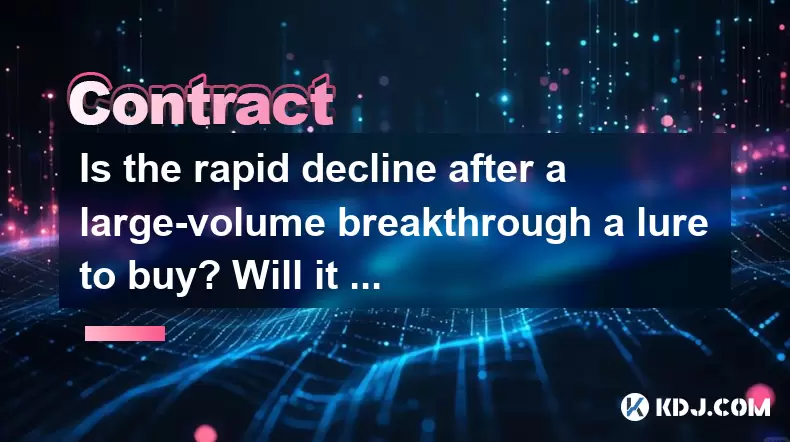-
 bitcoin
bitcoin $87959.907984 USD
1.34% -
 ethereum
ethereum $2920.497338 USD
3.04% -
 tether
tether $0.999775 USD
0.00% -
 xrp
xrp $2.237324 USD
8.12% -
 bnb
bnb $860.243768 USD
0.90% -
 solana
solana $138.089498 USD
5.43% -
 usd-coin
usd-coin $0.999807 USD
0.01% -
 tron
tron $0.272801 USD
-1.53% -
 dogecoin
dogecoin $0.150904 USD
2.96% -
 cardano
cardano $0.421635 USD
1.97% -
 hyperliquid
hyperliquid $32.152445 USD
2.23% -
 bitcoin-cash
bitcoin-cash $533.301069 USD
-1.94% -
 chainlink
chainlink $12.953417 USD
2.68% -
 unus-sed-leo
unus-sed-leo $9.535951 USD
0.73% -
 zcash
zcash $521.483386 USD
-2.87%
Is the rapid decline after a large-volume breakthrough a lure to buy? Will it continue to test the support level the next day?
Rapid declines after large-volume breakthroughs may be lures to buy; traders should analyze volume, technical indicators, and support levels to make informed decisions.
Jun 03, 2025 at 09:50 pm

Understanding the Rapid Decline After a Large-Volume Breakthrough
In the cryptocurrency market, traders often encounter scenarios where a rapid decline follows a large-volume breakthrough. This phenomenon can be perplexing and lead to various interpretations. One common question that arises is whether this decline is a lure to buy. To address this, we need to delve into the dynamics of market behavior and the psychology of trading.
A large-volume breakthrough typically indicates strong buying interest and can signal the beginning of a bullish trend. However, when a rapid decline follows, it may cause traders to question the validity of the breakout. This decline can be attributed to several factors, including profit-taking by early investors, market manipulation, or a natural correction after a significant move. Understanding these factors is crucial in determining whether the decline is a lure to buy.
Analyzing the Decline as a Lure to Buy
The concept of a decline as a lure to buy is rooted in the idea that savvy traders or market manipulators might intentionally drive the price down to shake out weaker hands and attract new buyers at a lower price. This tactic can create a false sense of a bearish trend, prompting those who missed the initial surge to enter the market, thereby driving the price back up.
To determine if the decline is indeed a lure, traders should look at several indicators. Volume is a critical factor; if the decline is accompanied by low volume, it might suggest that the downward movement is not supported by strong selling pressure. Additionally, technical indicators such as the Relative Strength Index (RSI) and Moving Average Convergence Divergence (MACD) can provide insights into whether the asset is oversold and due for a rebound.
The Role of Support Levels in Market Movements
After a rapid decline, the next day's market activity often focuses on testing support levels. Support levels are price points where an asset tends to find buying interest, preventing it from falling further. When a cryptocurrency experiences a large-volume breakthrough followed by a decline, it is common for the market to test these support levels to gauge the strength of the bullish sentiment.
Testing support levels the next day can provide valuable information about the market's direction. If the price holds above a key support level, it may indicate that the bullish trend is still intact, and the decline was merely a correction. Conversely, if the price breaks below the support level, it could signal a more significant bearish shift.
Strategies for Trading During Rapid Declines
When faced with a rapid decline after a large-volume breakthrough, traders need to employ strategic approaches to navigate the market effectively. Here are some strategies that can be used:
Wait for Confirmation: Instead of jumping into the market immediately after a decline, traders should wait for confirmation that the price is stabilizing or reversing. This can be done by monitoring price action and technical indicators.
Use Stop-Loss Orders: To manage risk, traders can set stop-loss orders below key support levels. This ensures that they can exit the market if the price continues to fall, limiting potential losses.
Analyze Market Sentiment: Understanding the broader market sentiment can provide insights into whether the decline is a temporary setback or a sign of a more significant trend change. This can be done by analyzing social media, news, and market reports.
Look for Reversal Patterns: Traders should be on the lookout for bullish reversal patterns, such as doji or hammer candlesticks, which can signal that the price is about to turn around.
Identifying False Breakouts and Market Manipulations
False breakouts and market manipulations are common in the cryptocurrency market and can lead to rapid declines after large-volume breakthroughs. Identifying these scenarios is essential for traders looking to capitalize on potential buying opportunities.
A false breakout occurs when the price briefly surpasses a key resistance level but fails to sustain the move, leading to a rapid decline. This can be identified by analyzing the price action and volume during the breakout. If the volume is not significantly higher than average, it might indicate a lack of genuine buying interest.
Market manipulations, on the other hand, involve deliberate actions by large traders or groups to influence the market. These manipulations can create the illusion of a breakout, followed by a rapid decline to lure in new buyers. To spot these manipulations, traders should look for unusual price movements, especially those that occur outside of regular trading hours or are accompanied by suspicious trading volumes.
Technical Analysis Tools for Assessing Rapid Declines
Technical analysis plays a crucial role in understanding and reacting to rapid declines after large-volume breakthroughs. Here are some key tools and indicators that traders can use:
Moving Averages: Moving averages help smooth out price data to identify trends. A crossover of short-term and long-term moving averages can signal potential trend reversals.
Bollinger Bands: Bollinger Bands consist of a moving average and two standard deviation lines. When the price touches the lower band after a decline, it may indicate that the asset is oversold and due for a rebound.
Fibonacci Retracement: Fibonacci retracement levels can help identify potential support levels after a decline. If the price bounces off a key Fibonacci level, it may suggest that the bullish trend is still intact.
Candlestick Patterns: Candlestick patterns, such as doji, hammer, and engulfing patterns, can provide insights into potential reversals. These patterns can be particularly useful in identifying buying opportunities after a rapid decline.
Case Studies of Rapid Declines After Large-Volume Breakthroughs
Examining real-world examples can provide valuable insights into how rapid declines after large-volume breakthroughs play out in the cryptocurrency market. Let's look at a couple of case studies:
Bitcoin (BTC) in 2021: In May 2021, Bitcoin experienced a large-volume breakthrough above $50,000, only to see a rapid decline shortly afterward. The decline was followed by a period of consolidation, with the price testing key support levels around $30,000. This case illustrates how a rapid decline can be a buying opportunity if the asset holds above critical support levels.
Ethereum (ETH) in 2020: In September 2020, Ethereum broke through the $400 resistance level with significant volume, but a rapid decline followed, bringing the price down to $300. The subsequent days saw the price testing the $300 support level, which held firm, leading to a strong rebound. This example shows how testing support levels can confirm the strength of a bullish trend.
Frequently Asked Questions
Q1: How can I differentiate between a genuine breakout and a false breakout?A1: To differentiate between a genuine and a false breakout, pay attention to the volume during the breakout. A genuine breakout is typically accompanied by high volume, indicating strong buying interest. In contrast, a false breakout may have lower volume and fail to sustain the move above the resistance level. Additionally, monitoring technical indicators like RSI and MACD can provide further confirmation.
Q2: What are the signs of market manipulation in cryptocurrency trading?A2: Signs of market manipulation include unusual price movements outside of regular trading hours, significant price spikes or drops without corresponding news or events, and suspicious trading volumes. These manipulations can be detected by analyzing price action and trading volumes over time and looking for patterns that deviate from normal market behavior.
Q3: How should I adjust my trading strategy after a rapid decline following a large-volume breakthrough?A3: After a rapid decline, consider the following adjustments to your trading strategy: wait for confirmation of a price stabilization or reversal, use stop-loss orders to manage risk, analyze market sentiment to understand broader trends, and look for bullish reversal patterns. These adjustments can help you make more informed trading decisions and capitalize on potential buying opportunities.
Q4: What role do psychological factors play in rapid declines after large-volume breakthroughs?A4: Psychological factors play a significant role in rapid declines after large-volume breakthroughs. Fear and greed can drive traders to make impulsive decisions, such as selling off their positions during a decline or buying into the market at the first sign of a rebound. Understanding these psychological drivers can help traders stay disciplined and avoid falling into traps set by market manipulators.
Disclaimer:info@kdj.com
The information provided is not trading advice. kdj.com does not assume any responsibility for any investments made based on the information provided in this article. Cryptocurrencies are highly volatile and it is highly recommended that you invest with caution after thorough research!
If you believe that the content used on this website infringes your copyright, please contact us immediately (info@kdj.com) and we will delete it promptly.
- Bitcoin's Rollercoaster: Grayscale Eyes New ATH Amidst Market Crashes
- 2025-12-16 22:15:02
- Bitcoin Buying Urgency: MicroStrategy's Aggressive Strategy Amid Market Shifts
- 2025-12-16 22:25:01
- DeFi Milestone: Mutuum Finance Secures Over $19M in Funding, Nears V1 Launch
- 2025-12-16 22:30:02
- Remembering Alexander Ray: A Visionary in Web3 and the Future of Albus Protocol
- 2025-12-16 22:10:01
- Rare 50p Coins Fetch Hundreds, Experts Warn Against Online Scams
- 2025-12-16 22:20:01
- Circle Acquires Interop Labs Team, Axelar Network (AXL) Price Dips Amid Community Concerns
- 2025-12-16 22:30:02
Related knowledge

Why is Risk-to-Reward Ratio Crucial in Futures Trading?
Dec 08,2025 at 01:20am
Risk-to-Reward Ratio Defined1. The risk-to-reward ratio quantifies the potential loss against the potential gain for a single futures trade. It is cal...

A Step-by-Step Guide on How to Short Bitcoin with Futures.
Dec 07,2025 at 06:39pm
Understanding Bitcoin Futures Contracts1. Bitcoin futures are standardized agreements to buy or sell BTC at a predetermined price and date in the futu...

Understanding the Relationship Between Leverage and Margin.
Dec 14,2025 at 02:39am
Core Mechanics of Leverage in Crypto Trading1. Leverage allows traders to control a larger position size than their available capital would normally p...

How to Reduce Trading Fees on Your Futures Account.
Dec 11,2025 at 01:20pm
Understanding Fee Structures in Futures Trading1. Exchanges apply distinct fee models based on order type—maker orders add liquidity and receive rebat...

How to Backtest Your Crypto Futures Trading Strategy for Free.
Dec 11,2025 at 12:20pm
Setting Up a Local Backtesting Environment1. Install Python 3.9 or higher on your machine using official distribution channels or package managers lik...

A Guide to Partial Liquidation and Tiered Margin Systems.
Dec 09,2025 at 07:59pm
Understanding Partial Liquidation Mechanics1. Partial liquidation occurs when a trader’s position breaches the maintenance margin threshold but does n...

Why is Risk-to-Reward Ratio Crucial in Futures Trading?
Dec 08,2025 at 01:20am
Risk-to-Reward Ratio Defined1. The risk-to-reward ratio quantifies the potential loss against the potential gain for a single futures trade. It is cal...

A Step-by-Step Guide on How to Short Bitcoin with Futures.
Dec 07,2025 at 06:39pm
Understanding Bitcoin Futures Contracts1. Bitcoin futures are standardized agreements to buy or sell BTC at a predetermined price and date in the futu...

Understanding the Relationship Between Leverage and Margin.
Dec 14,2025 at 02:39am
Core Mechanics of Leverage in Crypto Trading1. Leverage allows traders to control a larger position size than their available capital would normally p...

How to Reduce Trading Fees on Your Futures Account.
Dec 11,2025 at 01:20pm
Understanding Fee Structures in Futures Trading1. Exchanges apply distinct fee models based on order type—maker orders add liquidity and receive rebat...

How to Backtest Your Crypto Futures Trading Strategy for Free.
Dec 11,2025 at 12:20pm
Setting Up a Local Backtesting Environment1. Install Python 3.9 or higher on your machine using official distribution channels or package managers lik...

A Guide to Partial Liquidation and Tiered Margin Systems.
Dec 09,2025 at 07:59pm
Understanding Partial Liquidation Mechanics1. Partial liquidation occurs when a trader’s position breaches the maintenance margin threshold but does n...
See all articles










































































